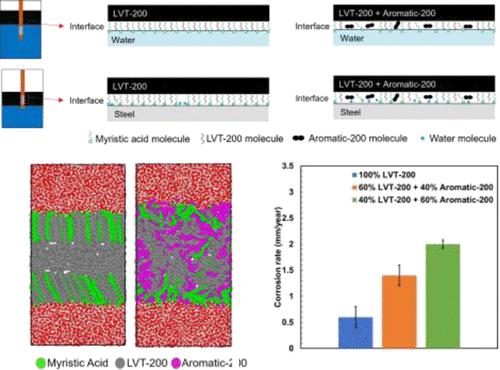Our official English website, www.x-mol.net, welcomes your
feedback! (Note: you will need to create a separate account there.)
Experiments and Molecular Simulations to Study the Effect of Surface-Active Compounds in Mixtures of Model Oils on CO2 Corrosion during Intermittent Oil–Water Wetting
Langmuir ( IF 3.7 ) Pub Date : 2024-05-01 , DOI: 10.1021/acs.langmuir.4c00052
Neda Norooziasl 1 , Abolfazl Faeli Qadikolae 1 , David Young 1 , Bruce Brown 1 , Sumit Sharma 1 , Marc Singer 1
Langmuir ( IF 3.7 ) Pub Date : 2024-05-01 , DOI: 10.1021/acs.langmuir.4c00052
Neda Norooziasl 1 , Abolfazl Faeli Qadikolae 1 , David Young 1 , Bruce Brown 1 , Sumit Sharma 1 , Marc Singer 1
Affiliation

|
Intermittent oil–water wetting can have a significant effect on the internal corrosion of steel pipelines. This paper presents a combined experimental and molecular modeling study of several influential factors on the surface properties and corrosion behavior of mild steel in CO2 environments. The influence of different model oils (LVT-200 and Aromatic-200) and select surface-active compounds (myristic acid, cyclohexane butyric acid, and oleic acid) on the corrosion behavior of carbon steel during intermittent oil–water wetting was determined by measuring the corrosion rate after intermittent wetting cycles. The interfacial tension measurements were performed to study the incorporation of the oil phase along with surface-active molecules in the protective layer formed on the specimen surface. Results showed that the interfacial tension for an aromatic oil–water interface is lower than that for an aliphatic oil–water interface. To understand this result, molecular dynamics simulations of oil–water interfaces were performed in the presence of surface-active molecules and different oils to analyze the structure of the layer formed at the interface. The simulations supported the hypothesis that aromatic molecules are less structured at the interface, which results in the incorporation of more water molecules into the protective layer formed at the steel surface, causing a higher corrosion rate. On the other hand, the simulations revealed that myristic acid in an aliphatic oil forms a well-aligned structure at the interface, devoid of any water molecules. This is in agreement with the hypothesis that the linear molecular structure of myristic acid favors the alignment of molecules at an aliphatic oil–water interface, resulting in a lower interfacial tension and more effective corrosion mitigation as compared to the other two nonlinear compounds tested. It is concluded that an important factor controlling the corrosion behavior is the molecular structure of the oil–water interface, which is adopted by the steel surface layer through the Langmuir–Blodgett process.
中文翻译:

通过实验和分子模拟研究模型油混合物中的表面活性化合物对间歇性油水润湿过程中 CO2 腐蚀的影响
间歇性油水润湿对钢质管道的内腐蚀有显着影响。本文对CO 2环境中低碳钢表面性能和腐蚀行为的几个影响因素进行了实验和分子模拟相结合的研究。通过测量不同型号油(LVT-200 和 Aromatic-200)和选择的表面活性化合物(肉豆蔻酸、环己烷丁酸和油酸)对间歇性油水润湿过程中碳钢腐蚀行为的影响间歇润湿循环后的腐蚀速率。进行界面张力测量是为了研究油相与表面活性分子在样品表面形成的保护层中的结合情况。结果表明,芳香族油水界面的界面张力低于脂肪族油水界面。为了理解这一结果,在表面活性分子和不同油存在的情况下进行了油水界面的分子动力学模拟,以分析界面处形成的层的结构。模拟支持了这样的假设:芳香族分子在界面处的结构较差,这导致更多的水分子结合到钢表面形成的保护层中,从而导致更高的腐蚀速率。另一方面,模拟显示脂肪油中的肉豆蔻酸在界面处形成排列良好的结构,不含任何水分子。 这与肉豆蔻酸的线性分子结构有利于脂肪族油水界面上的分子排列的假设是一致的,与测试的其他两种非线性化合物相比,导致较低的界面张力和更有效的缓蚀作用。结论是控制腐蚀行为的重要因素是油水界面的分子结构,该分子结构通过Langmuir-Blodgett过程被钢表面层采用。
更新日期:2024-05-01
中文翻译:

通过实验和分子模拟研究模型油混合物中的表面活性化合物对间歇性油水润湿过程中 CO2 腐蚀的影响
间歇性油水润湿对钢质管道的内腐蚀有显着影响。本文对CO 2环境中低碳钢表面性能和腐蚀行为的几个影响因素进行了实验和分子模拟相结合的研究。通过测量不同型号油(LVT-200 和 Aromatic-200)和选择的表面活性化合物(肉豆蔻酸、环己烷丁酸和油酸)对间歇性油水润湿过程中碳钢腐蚀行为的影响间歇润湿循环后的腐蚀速率。进行界面张力测量是为了研究油相与表面活性分子在样品表面形成的保护层中的结合情况。结果表明,芳香族油水界面的界面张力低于脂肪族油水界面。为了理解这一结果,在表面活性分子和不同油存在的情况下进行了油水界面的分子动力学模拟,以分析界面处形成的层的结构。模拟支持了这样的假设:芳香族分子在界面处的结构较差,这导致更多的水分子结合到钢表面形成的保护层中,从而导致更高的腐蚀速率。另一方面,模拟显示脂肪油中的肉豆蔻酸在界面处形成排列良好的结构,不含任何水分子。 这与肉豆蔻酸的线性分子结构有利于脂肪族油水界面上的分子排列的假设是一致的,与测试的其他两种非线性化合物相比,导致较低的界面张力和更有效的缓蚀作用。结论是控制腐蚀行为的重要因素是油水界面的分子结构,该分子结构通过Langmuir-Blodgett过程被钢表面层采用。































 京公网安备 11010802027423号
京公网安备 11010802027423号